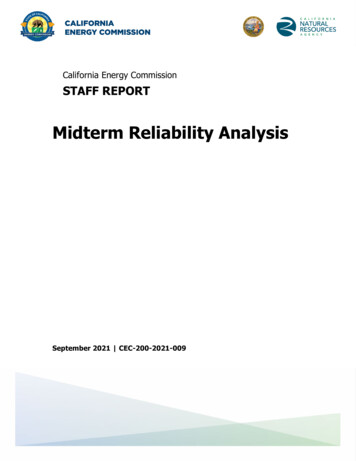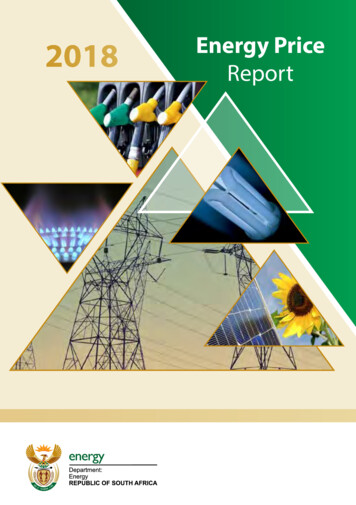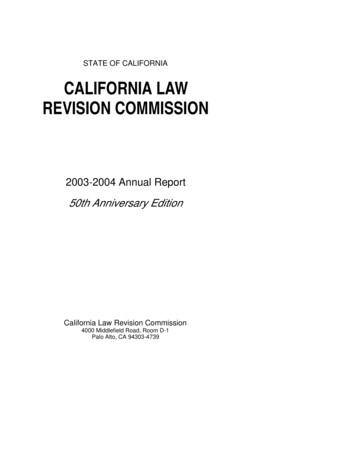
Transcription
California Energy CommissionSTAFF REPORTMidterm Reliability AnalysisSeptember 2021 CEC-200-2021-009
California Energy CommissionLiz GillMark KootstraElizabeth HuberChristopher McLeanBrett FooksPrimary Author(s)Liz GillProject ManagerDavid ErneOffice ManagerSUPPLY ANALYSIS OFFICEAleecia GutierrezDeputy DirectorENERGY ASSESSMENTS DIVISIONShawn PittardDeputy DirectorSITING, TRANSMISSION, AND ENVIRONMENTAL PROTECTIONDIVISIONDrew BohanExecutive DirectorSiva GundaVice Chair, Lead Commissioner on ReliabilityKaren DouglasCommissioner, Lead Commissioner on Power Plant ProgramDISCLAIMERStaff members of the California Energy Commission prepared this report.As such, it does not necessarily represent the views of the EnergyCommission, its employees, or the State of California. The EnergyCommission, the State of California, its employees, contractors andsubcontractors make no warrant, express or implied, and assume no legalliability for the information in this report; nor does any party representthat the uses of this information will not infringe upon privately ownedrights. This report has not been approved or disapproved by the EnergyCommission nor has the Energy Commission passed upon the accuracy oradequacy of the information in this report.
ACKNOWLEDGEMENTSThe CEC appreciates the contributions from the following staff.California Energy CommissionLinda BarreraJim BartridgeHannah CraigTravis DavidLe-Quyen NguyenAngela TanghettiCalifornia Public Utilities CommissionSimon BakerNathan BarcicJames McGarryJason OrtegoNeil RaffanMolly Sterkeli
ABSTRACTThis report provides the results of analyses conducted by CEC staff to inform decisions aboutthe need for future resource procurement to support reliability for the midterm (2023 – 2026).The report addresses multiple questions associated with reliability over this period, includingloss of load expectation modeling, assessment of risks to reliability from a growing amount ofbattery energy storage system resources on the grid, and an evaluation of additional thermalgeneration sources that could support reliability. The report is prepared for the CaliforniaPublic Utilities Commission to consider as part of their Integrated Resource PlanningProceeding (R.20-05-003) as they decide whether to adopt the preferred system plan by theend of 2021.Keywords: System reliability, clean energy resources, loss of load expectation, battery energystorage system, natural gas fleet, thermal resourcesPlease use the following citation for this report:Gill, Liz, Mark Kootstra, Elizabeth Huber, Brett Fooks, Chris McLean. 2021. Midterm ReliabilityAnalysis. California Energy Commission. Publication Number: CEC-200-2021-009.ii
TABLE OF CONTENTSPageMidterm Reliability Analysis. iAcknowledgements . iAbstract . iiTable of Contents .iiiList of Figures . vList of Tables. viExecutive Summary . 12023 – 2026 Reliability Modeling . 1Battery Energy Storage Systems on the Grid . 2Role of the Natural Gas Fleet . 3CHAPTER 1: Introduction . 4Reliability Analysis and Considerations . 5Midterm Reliability Assessment . 6CHAPTER 2: 2023 - 2026 Reliability Modeling . 7Approach . 7Results . 11Incremental Thermal Capacity . 12Track 1 Conclusions . 14CHAPTER 3: Battery Energy Storage Systems on the Grid . 15BESS Performance on the Grid: 2021 vs Previous Years . 16Reliability Impacts of Potential Procurement Delays . 18Ability to Sufficiently Charge BESS . 19Growing but Limited Experience with BESS Operations and Safety . 21Ongoing CEC work tracking BESS Deployment and Safety . 22Track 2 Conclusions: . 23CHAPTER 4: Role of the Natural Gas Fleet . 24Additional Capacity Approved by CEC But Not Yet Built . 26Cradle-to-Cradle Opportunities . 27CHAPTER 5: Conclusions & Limitations . 28Glossary. 30APPENDIX A: 2021 California Reliability Outlook . A-1Introduction . A-1iii
Background . A-1Hourly Stack Analysis . A-1Loss of Load Expectation Analyses . A-2Purpose and Scope of 2021 California Reliability Outlook . A-2Analytical Approach . A-3Inputs and Assumptions . A-4System Inputs and Assumptions . A-4Resource Inputs and Assumptions . A-7New Resource Build Assumptions . A-12Base Resource Assumptions . A-15Modeling Scenarios . A-19Capacity Additions . A-23Include 2026 . A-26Import and Hydro Limits . A-26Gas in Place of Zero-emitting Resources. A-26New ELCC Values . A-26BESS Supply Chain Impact . A-27Solar Output Reductions . A-27Results . A-27No Build Scenario . A-27PSP Scenarios. A-28Procurement Order Scenarios . A-29Energy Limited Cases . A-32BESS Supply Chain Delays . A-36Conclusions . A-37On Need for Additional Capacity: . A-37On Reliability Impacts of Incremental Thermal Capacity . A-38On Energy Sufficiency Relating to BESS Charging Needs: . A-38On BESS Supply Chain Concerns for Reliability: . A-38APPENDIX B: Electric System Reliability and the Recent Role of California’s Fossil Fleet . B-1Recent Heat Events and System Reliability Problems in California. B-3Dispatchable Generation Is Integral to a Reliable System . B-4Additional Capacity Approved by CEC but Not Yet Built . B-11Additional Outreach . B-13Communication with Jurisdictional Power Plants . B-13Jurisdictional Fleet Survey . B-13Second Lead Commissioner Public Workshop . B-14California Energy Commission Emergency Responsibilities . B-15Expedited Facility Change Petition Process . B-15Temporary Power Generator Licensing . B-16Battery Storage System Licensing . B-16iv
LIST OF FIGURESPageFigure 1: Comparison of the Nameplate Capacity Necessary to Provide 1 MW NQC . 9Figure 2: Comparison of the Nameplate Capacity Necessary to Provide 1 MW NQC of BESS,Wind and Gas . 10Figure 3: LOLE Results for the Procurement Orders . 11Figure 4: Comparison of the Procurement Order Scenario and Thermal Replacement Portfolio. 13Figure 5: LOLE Results for the Procurement Order Replaced with Thermal Capacity . 13Figure 6: BESS Grid Performance for 2020 and 2021 . 17Figure 7: Loss of Load Expectation for the BESS Supply Chain Scenarios . 19Figure 8: Loss of Load Expectation Comparison for Energy Limited Cases . 20Figure 9: Number of Unserved Energy Events by Time of Day, 2022 . 21Figure 10: Net Qualifying Capacity Resulting from CEC Actions Since November 2020 . 26Figure 11: Additional Capacity Approved by CEC But Not Constructed . 27Figure A-1: 2022 Load Duration Curves for the Demand Distribution Compared to the 2020CED for 2022. A-6Figure A-2: Unserved Energy Event Magnitude, No Build Scenario . A-28Figure A-3:Loss of Load Expectation, PSP-Based Scenarios. A-29Figure A- 4: Loss of Load Expectation, Order Based Scenarios . A-30Figure A-5: Unserved Energy Event for the Order (Shift) Scenarios . A-32Figure A- 6: Loss of Load Expectation Comparison for Energy Limited Cases. A-33Figure A-7: 2022 Unserved Energy Event for the Order (Energy) Scenarios with DecreasingSolar Production . A-34Figure A- 8: 2026 Unserved Energy Event for the Order (Energy) Scenarios with DecreasingSolar Production . A-35Figure A- 9: Number of Unserved Energy Events by Time of Day, 2022 . A-36Figure A-10: Loss of Load Expectation for the BESS Supply Chain Scenarios . A-36Figure B-1: Net Qualifying Capacity Resulting from CEC Actions Since November 2020 . B-2Figure B-2: Solar Output in California ISO on August 1, 14, and 31, 2021 . B-5v
Figure B-3: California ISO Changing Resource Mix as Solar Generation Declined on August 1,2021. B-6Figure B-4: Jurisdictional Facility MW Capacity Upgrades for Summer 2021 JurisdictionalFacility MW Capacity Upgrades for Summer 2021 . B-10Figure B-5: Additional Capacity Approved by CEC but Not Constructed . B-12Figure B-6 Permitted and Potential Capacity 2022–2026 . B-17LIST OF TABLESPageTable 1: Cumulative Procurement Order Requirements . 8Table 2: No Build Shortfall Capacity Compared to NQC Additions . 12Table 3: Reduction in the Total Installed Capacity for 4-Hour Energy Storage . 18Table A-1: Generating Capacity Capable of Providing Reserves . A-6Table A-2: Minimum Generation Values Used for Select Scenarios . A-8Table A-3: Shifting of Capacity Need from Demand to Reserves . A-9Table A-4: Forced Outage and Unit Size Assumptions . A-10Table A-5: BESS Properties . A-11Table A-6: Technology Factors by Month . A-13Table A-7: Marginal ELCC Values in the CPUC's Reliability Need Determination Model . A-14Table A-8: Annual 2021 ELCC Values for D.21-06-035 . A-15Table A-9: IRP Baseline Resources . A-16Table A-10: IRP Baseline Additions per LSE Filings . A-17Table A-11: Summer 2021 Procurement . A-18Table A-12: Total Baseline Nameplate Capacity for Resource Adequacy . A-19Table A-13: Scenario Summary . A-21Table A-14: Capacity Removed from the PSP Due to Overlap with the Base Resources . A-23Table A-15: PSP Incremental Resource Additions. A-24Table A-16: NQC Values for the PSP . A-24Table A-17: Cumulative Procurement Order Requirements and Estimates of the ResourceTypes and Amounts to Comply . A-25vi
Table A-18: Order Resource Build Additions using the Reliability Need Determination ModelMarginal ELCC Values. A-25Table A-19: Order Resource Build Additions using the ELCC Values for D.21-06-035. A-26Table A-20: Reduction in the Total Installed Capacity for 4-Hour BESS . A-27Table A-21: Reliability Statistics Summary, No Build Scenario . A-28Table A-22: Results for the Capacity Shift Scenarios . A-31Table A-23: No Build Shortfall Capacity Compared to NQC Additions . A-37vii
viii
EXECUTIVE SUMMARYRecent California and west-wide extreme heat events attributed to the impacts of climatechange in 2020 and 2021 have resulted in the need for a closer look at the need for additionalgeneration resources for the state to bolster reliability. In addition to potential climate changeimpacts, the state will have a critical transition period over the next five years as nearly 6,000MW of older firm and dispatchable resources are expected to be retired. At the same time, thestate continues to expand deployment of renewable resources to support SB 100 targets andplan for increased electrification.In response to the rotating outages the state experienced in August 2020, the CaliforniaEnergy Commission (CEC), California Public Utilities Commission (CPUC), and CaliforniaIndependent System Operator (CAISO) developed the Final Root Cause Analysis (RCA) forGovernor Gavin Newsom. 1 The RCA highlighted the importance of adequately planning for achanging generation mix, accounting for climate change impacts, and making sure thatsufficient resources are available to serve load during the net peak period, to ensure reliability.Over the past two years, the CPUC has issued two decisions for additional procurement in theIntegrated Resource Planning proceeding. In their June 30, 2021 decision, the CPUC orderedthe procurement of 11,500 MW of net qualifying capacity (NQC) to come online from 2023 to2026. 2 While the proposed decision included authorization to procure up to 1,500 MW NQC ofincremental thermal capacity, the final decision removed consideration of fossil-fueledcapacity, but noted that additional procurement of fossil-fueled capacity would be evaluatedbased on additional analysis from the CPUC and CEC, including the analysis in this report, forthe decision adopting the CPUC’s preferred system plan by the end of 2021.This report addresses three analytical tracks to inform the CPUC’s decision. The first track isthe CEC’s reliability modeling for the years 2023 – 2026. The second track addresses questionsassociated with the growth of battery energy storage (BESS) on the grid and the implicationsfor reliability. The third track addresses options for additional thermal resources, if needed.2023 – 2026 Reliability ModelingThis track of the report includes results of the CEC’s first California Reliability Outlook (CRO).The CRO was developed in response to the RCA to help provide situational awareness andsupport reliability planning in the near-, mid-, and long-term. The scope for this first versionwas primarily informed by the immediate needs of the CPUC’s midterm reliability decision andwas developed in close collaboration with CPUC staff and stakeholder input. The analysisaddressed the following questions:1 Final Root Cause Analysis Mid-August 2020 Extreme Heat Wave. 2021. California Independent System Operator. Available Analysis-Mid-August-2020-Extreme-Heat-Wave.pdf.2 Decision Requiring Procurement to Address Mid-term Reliability (2023-2026). D.21-06-035. June 30, 2021. Available /G000/M389/K603/389603637.PDF.1
Whether additional capacity beyond current procurement orders is needed to maintainsystem reliability. Whether incremental thermal resources provide an additional system reliability benefitcompared to a portfolio of zero-emitting resources.The analysis reached the following conclusions: The ordered resource procurement for 2023 through 2026 appears to be sufficient tomeet a 1 day in 10-year loss of load expectation (LOLE) target, indicating systemreliability. The reliance on zero-emitting resources does not appear to diminish reliabilitycompared to procuring thermal resources.Further considerations include: This study did not include resource retirements beyond those assumed in the CPUC’smid-term reliability decision. Additional retirements would increase the likelihood ofsystem reliability challenges.Additionally, the CEC demand forecast is being further enhanced to capture thefrequency and dispersion of extreme climate impacts. This new climate analysis orincreased electrification could necessitate planning for a higher demand andcharacteristics that are not captured in current analysis.Battery Energy Storage Systems on the GridThis track includes an assessment of potential risks associated with increasing deployment ofbattery energy storage systems (BESS) on the California grid. BESS resources havesubstantially increased in recent years and are expected to continue to grow as the BESSmarket matures. However, as would be expected of any new application of a technology, thereare concerns to be addressed, such as whether the systems are performing as needed,particularly during net peak, whether supply chain issues will affect deployment and gridreliability, and whether safety risks of systems, particularly lithium-ion batteries, can bemitigated.The analysis reached the following conclusions: The current procurement orders could result in adding in excess of 10 GW of new BESSto the CAISO system in order to support peak and net peak loads.Modeling indicates BESS performance does not appear to be a limiting factor to systemreliability in the midterm timeframe. In 2021, CAISO dispatch data indicates that inaggregate, BESS supported meeting the net peak load.Modeling indicates that a one-year delay of 20% of new BESS resources, potentiallyresulting from supply chain issues, would not, by itself, jeopardize system reliability.However, further procurement delays due to either supply chain constraints orpermitting or interconnection timelines, beyond those modeled in this analysis, couldcontribute to system reliability challenges. It is essential that state agencies and CAISOdevelop solutions to ensure timely interconnection of resources.2
Modeling suggests that there is sufficient energy on the system to adequately chargeBESS resources to support system reliability, even under energy constrained conditions,owing to limited imports, hydro generation and reductions in solar output.BESS performance and safety should continue to be monitored by CEC and otherrelevant state agencies and safety frameworks continued to be improved to ensure bothpublic safety and reliability. Higher levels of outage rates, lengths of an outage etc.,than assumed in the modeling could have significant effect on the modeling results andneed to be carefully considered as more data becomes available. It would be prudent toretain current levels of capacity supporting peak and net peak demands until BESSperformance has been further demonstrated.Role of the Natural Gas FleetThis track provides information on the incremental capacity options at existing natural gasfacilities and the permitting timelines should there be a need for incremental thermal capacityto maintain system reliability over the coming decade.3
CHAPTER 1:IntroductionThe next five years represent a critical transition period for California’s electric grid. Nearly6,000 MW of firm and dispatchable resources are expected to be retired, including theremaining once-through-cooling (OTC) plants and Diablo Canyon Nuclear Power Plant. At thesame time, the state continues to expand deployment of renewable resources to support SB100 (De León, Chapter 312, Statutes of 2018) targets, 3 plan for increased electrification, andplan for climate induced demand and supply uncertainties. As the state continues its transitiontoward clean resources, it is vital to ensure that the transition is reliable and equitable, both ofwhich have been brought into focus following the rotating outages in August 2020.The Final Root Cause Analysis (RCA) — prepared for Governor Gavin Newsom jointly by theCalifornia Energy Commission (CEC), California Public Utilities Commission (CPUC), andCalifornia Independent System Operator (CAISO) following the rotating outages - highlightedthe importance of adequately planning for a changing generation mix, accounting for climatechange impacts, and making sure that sufficient resources are available to serve load duringthe net peak period, to ensure system reliability. 4Thermal resources that have been relied upon primarily to support the reliability and rampingneeds, especially during the net peak hours, must be augmented with zero-emitting resources,battery energy storage systems (BESS) and other zero-carbon dispatchable resources. Thistransition to a more diversified portfolio of resources provides additional challenges to planningfor grid reliability and needs to be carefully considered.In response to the projected capacity needs over the next five years, the CPUC issued DecisionD.19-11-016 in the Integrated Resource Planning (IRP) Proceeding (R.20-05-003) orderingprocurement of 3,300 MW Net Qualifying Capacity (NQC) by August 1, 2023. 5 Additionally, onJune 30, 2021, the CPUC issued midterm reliability decision D.21-06-035 ordering theprocurement of 11,500 MW NQC from resources that are zero-emission or RenewablesPortfolio Standard (RPS) eligible to come online from 2023 to 2026. 6 While the proposeddecision included authorization to procure up to 1,500 MW NQC of incremental thermal3 SB 100, also known as the 100 Percent Clean Energy Act of 2018, is landmark legislation that established the state policy that renewableand zero-carbon resources supply 100 percent of retail sales and electricity procured to serve all state agencies by 20454 Final Root Cause Analysis Mid-August 2020 Extreme Heat Wave. 2021. California Independent System Operator. Available Analysis-Mid-August-2020-Extreme-Heat-Wave.pdf.5 Decision Requiring Electric System Reliability Procurement for 2021-2023. D.19-11-016. November 7, 2019. Available /G000/M319/K825/319825388.PDF.6 Decision Requiring Procurement to Address Mid-term Reliability (2023-2026). D.21-06-035. June 30, 2021. Available /G000/M389/K603/389603637.PDF.4
capacity, the final decision removed consideration of fossil-fueled capacity, but noted thatadditional procurement of fossil-fueled capacity would be evaluated based on additionalanalysis from the CPUC and CEC, including the analysis in this report, for the decision adoptingthe CPUC’s preferred system plan by the end of 2021.The decision called out the need for procurement, requiring that half of the 2026 resources beprovided by long-duration storage (eight hours or greater). Further the 2,500 MW ofreplacement for Diablo Canyon Nuclear Power P
Commissioner, Lead Commissioner on Power Plant Program. DISCLAIMER Staff members of the California Energy Commission prepared this report. As such, it does not necessarily represent the views of the Energy Commission, its employees, or the State of California. The Energy Commission, the State of California, its employees, contractors and










